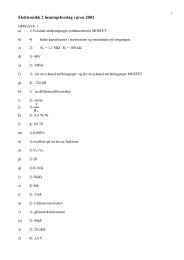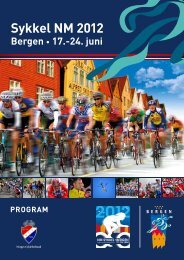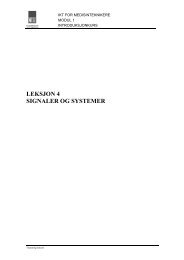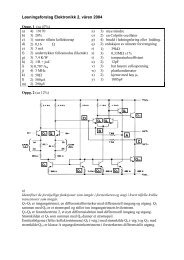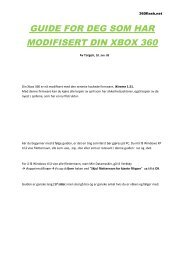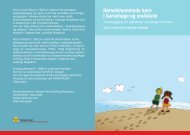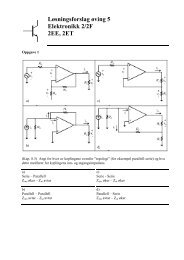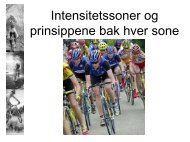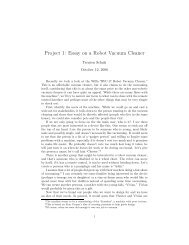The Online World resources handbook
The Online World resources handbook
The Online World resources handbook
You also want an ePaper? Increase the reach of your titles
YUMPU automatically turns print PDFs into web optimized ePapers that Google loves.
Using online services http://home.eunet.no/~presno/bok/3.html<br />
displayed on your screen.<br />
<strong>The</strong> characters you see on your computer's screen are based on a code. <strong>The</strong><br />
computer finds the characters to display from a table built into your system's hardware<br />
or software.<br />
Most personal computers can be preset to use various tables depending on your<br />
needs. When communicating in English, you may want it to show Latin characters.<br />
When writing in Japanese, you may want it to display Kanji characters.<br />
Those writing in Norwegian, often want to use the special Scandinavian characters<br />
¯ÿÊ Â . If the first two of these Nordic characters read like the symbols for Yen and<br />
Cent, you are not set up for Scandinavian characters. If your system is set up correctly,<br />
they should look like an 'o' and an 'O' overwritten by a '/'.<br />
To read or create non Roman web pages or email, you may be required to have<br />
these special fonts installed in your computer.<br />
<strong>The</strong> code telling your computer what to display, may also contain information about<br />
where to put characters and what colors to use.<br />
An online service may order your computer to display a given character in column<br />
10 on line 2, and to print it in blinking red color. If you are not set up correctly, these<br />
codes may show as garbage on your screen rather than as a colorful character in a given<br />
position.<br />
If you call a service set to display text in VT 52 format, and your communications<br />
program is set accordingly, then you should be OK. VT 52 is a setup that makes a<br />
program or a service 'behave' like a DEC VT 52 terminal.<br />
Being able to view VT 52 coded text on your screen, does not guarantee that you<br />
can capture this 'picture' to a file on your disk. Your communications program may need<br />
special features to do that. If these features are missing, you are in for a surprise. <strong>The</strong><br />
text in your capture file may look like in this example (on my computer, it came on a<br />
single, long line ):<br />
**H*J*Y"4 Innhold*Y%><br />
*Y&4Emneoversikt 1 Brukerprofil 6*Y)<br />
4Stikkord A ] 2 Bruker *Y*4 veile<br />
dning 7*Y,4Informasjons<br />
*Y 4leverand|rer A ] 3 Teledatanytt*Y.W<br />
8*Y04Personlig indeks 4*Y2H *Y3<br />
4Meldingstjenesten 5 Avslutte9*Y64 ]pningsside<br />
*00# *Y 4TELEDATA 880823 1538*<br />
Y74 NTA01 00a*Y74<br />
*Y74*Y74<br />
<strong>The</strong> character '*' in this example refers to the ESCape character (ASCII number 27).<br />
ESC is used to tell your computer that what follows is a VT 52 display command. <strong>The</strong><br />
codes following ESC say where text is to be printed on your screen (from line number x<br />
and column number y).<br />
If your communications program cannot save VT 52 coded text in a readable way,<br />
you'll need auxiliary programs to remove or convert the codes. Some communication<br />
programs let you take snapshots of the screen, and store the result in a file. This usually<br />
gives good results, but it may be a cumbersome approach.<br />
Minitel (in France and the U.S.) belongs to a group of online services called<br />
videotex (or viewdata). <strong>The</strong>y believe that beautiful color graphics, large characters, and<br />
menus give them a competitive advantage.<br />
Viewdata services use graphical display standards with names like CEPT, Captain<br />
(Character and Pattern Telephone Access Information Network System), Telidon,<br />
Minitel, Teletel, GIF (the Graphics Interchange Format), Viewdata, and NAPLPS (<strong>The</strong><br />
North American Presentation Level Protocol Syntax).<br />
Often, you'll need special terminal machines to use viewdata services. On other<br />
services, you must use special software plus an emulator card in your computer.<br />
Many MS DOS based bulletin boards let you set access defaults to colors and<br />
graphics. Most of them use ANSI graphics in welcome texts and menus. Users must set<br />
their programs to ANSI (or ANSI BBS) to take advantage.<br />
Capture these welcome texts and menus to a file on your hard disk, and view them<br />
with an editor. <strong>The</strong>y are filled with ANSI escape codes, and thus hard to read or search.<br />
5 of 6 23.11.2009 15:44



